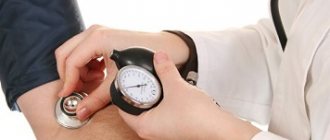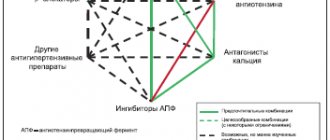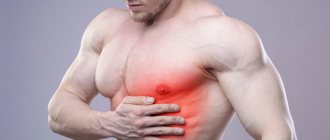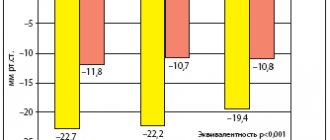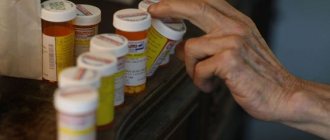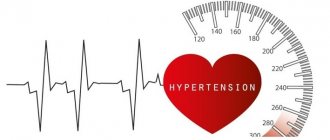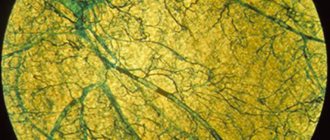Prevention of arterial hypertension
Arterial hypertension is a leading risk factor for the development of cardiovascular, cerebrovascular and renal diseases.
Prevention of hypertension can be primary (aimed at preventing the onset of the disease) and secondary (prevention of complications, prevention of the development of hypertensive crises, control of blood pressure levels).
Primary prevention is necessary for patients who have a predisposition to the appearance and development of arterial hypertension:
- men 35-50 years old;
- women after menopause;
- women taking estrogen-containing drugs;
- persons experiencing constant stressful situations;
- patients with cerebral atherosclerosis, cardiovascular diseases, kidney pathologies and diabetes mellitus;
- patients with high blood cholesterol levels;
- smokers;
- persons who frequently drink strong alcoholic drinks.
Primary prevention of arterial hypertension involves:
1. Increase in physical and physical activity.
2. Stop smoking.
Tobacco and the nicotine it contains contribute to arterial spasm. At first the spasm is temporary, then it becomes permanent. In addition, smoking contributes to ischemia of the heart muscle.
3. Stop drinking alcohol.
Limit daily consumption of table salt. Excess salt in the diet contributes to fluid retention in the body, increasing the volume of circulating blood, which over time leads to a persistent increase in blood pressure. To avoid this, you must adhere to the following rules:
- do not add salt to food after cooking;
- limit salt intake to 4.5-5 grams per day;
- exclude various pickles (pickles, herring) from consumption;
- if possible, replace table salt with spices and herbs;
- limit the consumption of foods high in salt (cheese, smoked meats, sausage, canned food, chips, crackers, peanuts, mayonnaise).
4. Nutrition optimization.
The most important factors are such factors as excessive consumption of coffee, chocolate and strong tea, consumption of large amounts of animal fats and simple carbohydrates, regular consumption of salty foods, and overeating.
A serious risk factor for hypertension is atherosclerosis. It occurs due to the deposition of atherosclerotic plaques on the walls of blood vessels. To avoid this, you should limit your intake of animal lipids. They are found in large quantities in sour cream, sausages, pork, lamb, and fatty cheeses. Pork can be replaced with beef or veal. It is advisable to drink skim milk. Potassium-rich foods should be included in your diet. These include dried apricots, bananas, baked potatoes, egg yolks, prunes, and raisins.
5. Correction of body weight.
The calorie content of food should not be high. You need to eat food in small portions. Excess weight is associated with the abuse of foods rich in simple carbohydrates (baked goods, cakes, fast food). It is necessary to include more fresh fruits and vegetables in your diet.
6. Maintaining sleep and wakefulness.
Night sleep should be 8-9 hours. Daytime sleep cannot fully replace nighttime sleep. If possible, night work should be replaced by day work. Things like snoring and sleep apnea can also cause hypertension.
7. Elimination of stressful conditions.
Stress is a trigger factor for many diseases. During it, the sympathetic system is activated. Stress hormones (adrenaline and norepinephrine) are released into the blood in large quantities, which cause vasospasm.
Secondary prevention of hypertension is indicated for patients in whom arterial hypertension has been diagnosed. It is aimed at:
- decreased blood pressure;
- prevention of hypertensive crises;
- prevention of secondary changes in organs and the development of complications.
The range of such events includes:
- non-drug treatment (more stringent measures corresponding to primary prevention);
- drug therapy.
For non-drug treatment, in addition to following the recommendations for the primary prevention of hypertension, as well as in the complex of measures, it is recommended to include:
- physiotherapeutic procedures in the absence of contraindications;
- physical therapy;
- psychotherapeutic trainings and auto-trainings;
- sanatorium-resort treatment in local cardiological sanatoriums and climatic resorts.
Comprehensive prevention and treatment of hypertension may include drugs from various pharmacological groups.
Drug therapy is prescribed to all patients with a persistent increase in blood pressure and patients with several risk factors for the development of diseases of the cardiovascular system.
The selection of drugs, their dosage, regimen and duration of administration are determined individually for each patient, based on data on his state of health. Taking medications for hypertension should be carried out constantly and under the supervision of the attending physician.
Comprehensive measures to prevent hypertension allow you to keep arterial hypertension under constant control and significantly reduce the risk of developing various severe complications.
Many diseases nowadays are not hereditary and their development can be prevented. As hypertension becomes more and more common, it is important to focus your efforts on preventing the disease from developing. Prevention includes a number of measures that are aimed at normalizing lifestyle; it can be of two types.
PRIMARY - helps prevent the occurrence of the disease. This is where measures that help change the lifestyle of a relatively healthy person for the better are important.
SECONDARY prevention is carried out in patients in whom arterial hypertension is diagnosed. Its goal is to prevent the occurrence of complications (heart attack, stroke). Moreover, this type of prevention includes two components: non-drug treatment of arterial hypertension and antihypertensive (drug) therapy.
THE BASIS OF NON-DRUG TREATMENT OF HB IS LIFESTYLE CHANGES
Firstly, you urgently need to reduce emotional stress, accept and change stressful situations in your life. We should strive to reduce the overall level of emotional stress in everyday life. It is better to consult a psychologist for help.
Complete smoking cessation. Nicotine has been shown to inhibit the effectiveness of some antihypertensive drugs. Moreover, smoking itself increases the risk of cardiovascular complications and other pathologies, including cancer.
Refusal of alcohol consumption. It is important to understand that dependence on it is terrible. The consequences are liver pathology, and its role in blood pressure regulation can hardly be overestimated. The daily possible alcohol consumption for men is 20-30g. pure ethanol (50-60g vodka, 200-250 ml wine, 0.5 liter beer), for women - half as much. Drinking more alcohol is accompanied by an increase in blood pressure, at the same time the effectiveness of medications also decreases, which is especially fraught for hypertensive patients. Better stop drinking.
Review of diet. A person prone to high blood pressure should have more vegetables on the menu than fruits, cereals, wholemeal products, fiber, natural products, unsaturated fatty acids (olive, flaxseed oil, fish from the northern seas), and dairy products. You need to reduce the amount of carbohydrates (sugar, confectionery products made from premium flour), animal fats, and foods containing large amounts of cholesterol. Particular attention should be paid to drinking water, which should be of medium hardness. Water that is too soft contains little calcium and magnesium salts, which are necessary for normal heart function. The heart also needs potassium, its source is potatoes, natural juices, as well as fresh vegetables and fruits. Reducing the consumption of table salt is important. The recommended norm is 3-4 grams per day. The contribution of salt (sodium chloride) to the development of hypertension is quite large, since salt retains fluid in the vessels, hence the increase in pressure.
Reducing excess body weight. As is known, excess weight contributes to the development of diabetes, increased cholesterol in the blood and the deposition of plaques in blood vessels, and leads to an increase in heart size - all of these are risk factors for hypertension. It has been noted that a decrease in body weight by 10 kg reduces the “upper” pressure by 5-20 mmHg. Maintaining a body mass index between 19 and 25 is considered ideal.
No one argues about the importance of physical activity. But there are only a few lovers of movement. Regular physical training enhances the hypotensive effect of diet and other non-drug methods of lowering blood pressure. It is recommended to carry out systematic aerobic physical exercise, especially for people with a sedentary lifestyle (office workers, drivers). The loads must correspond to the person’s abilities: it is unacceptable to overexert yourself, since in this case the pressure will, on the contrary, increase. Walking works best (up to 5-6 km daily), light running (up to 45 minutes a day, 3-4 times a week). Swimming effectively helps reduce blood pressure. If the blood pressure level is very high, physical therapy is allowed only after achieving optimal blood pressure.
When changing your lifestyle, you need to remember that it may not replace taking medications (if prescribed by a doctor), but only complements them. Consistently following the recommendations of the treating doctor, contacting him in a timely manner if the condition worsens. We must not forget that the patient’s health is in the hands of the patient himself, and the Russian concept that “to treat is their job” is extremely incorrect.
DRUG THERAPY are drugs prescribed by a doctor that specifically act on high blood pressure levels, reducing it. Secondary prevention of arterial hypertension includes systematic monitoring of blood pressure levels in the morning and evening. Patients with arterial hypertension should take such drugs for life, thereby preventing the risk of complications. It is important to be under medical supervision.
BASIC PRINCIPLES OF DRUG THERAPY FOR HB
- long-term (“lifelong”) medication is required;
- the dose of the drug cannot be set once and for all;
— medications are prescribed taking into account risk factors and concomitant diseases (“each patient has his own”);
- it is better to use long-acting drugs (so that it is convenient to take it 1-2 times a day);
— it is advisable to use a combination of two (sometimes three) drugs.
IF THE PRESSURE INCREASES SHARPLY AND A CRISIS DEVELOPES...
— It is necessary not only to measure blood pressure, but also to write it down in a diary or on a piece of paper;
- Call an ambulance;
— Place quick-acting drugs under the tongue: clonidine (clonidine) or captopril (Capoten) or nifedipine (Corinfar).
- If chest pain occurs (manifestation of angina), put nitroglycerin under the tongue.
- Do not sharply reduce blood pressure over a short period of time.
Prevention of hypertension
Arterial hypertension is one of the most common diseases of the cardiovascular system.
It has been established that 20-30% of the adult population suffer from arterial hypertension. With age, the prevalence of the disease increases and reaches 50–65% in people over 65 years of age. Despite the efforts of scientists, doctors and administrative bodies at various levels, arterial hypertension in the Russian Federation will remain one of the most significant medical and social problems. This is due to both the widespread prevalence of this disease (about 40% of the adult population of the Russian Federation has high blood pressure), and the fact that arterial hypertension is the most important risk factor for major cardiovascular diseases - myocardial infarction and cerebral stroke, which mainly determine high mortality in our country.
Hypertension (essential hypertension, primary hypertension) is a chronic disease characterized by a long-term and persistent increase in blood pressure, caused by disruption of the heart and regulation of vascular tone and not associated with diseases of the internal organs. The leading symptom of hypertension is an increase in blood pressure, caused primarily by neurofunctional disorders of the regulation of vascular tone. It is necessary to carefully differentiate hypertension from symptomatic hypertension, when increased blood pressure is a symptom of the disease, and, moreover, not the main one. Symptomatic hypertension is observed with coarctation of the aorta, atherosclerosis of the aorta and its large branches, dysfunction of the endocrine glands (Cushing's disease, pheochromacytoma, hyperthyroidism, primary aldesteronism-Conn's syndrome), damage to the renal parenchyma, occlusive damage to the main renal arteries, brain tumors, etc. .
Classification of hypertension
Hypertension is classified according to the degree of increase in blood pressure:
Optimal blood pressure is less than 120/80 mm. Hg Art.
Normal blood pressure is 120-129/80-84 mm. Hg Art.
High normal blood pressure – 130-139/85-89 mm. Hg Art.
I degree of arterial hypertension (mild) – 140-159/90-99 mm. Hg Art.
II degree of arterial hypertension (moderate) – 160-179/100-109 mm. Hg Art.
III degree of arterial hypertension (severe) – 180 or more / 110 or more mm. Hg
There are 3 stages in the development of hypertension:
Stage 1 – minor and unstable changes in blood pressure, without dysfunction of the cardiovascular system;
Stage 2 – constant changes in blood pressure, accompanied by left ventricular hypertrophy, but without other organic changes;
Stage 3 – constant high blood pressure with changes in the heart (coronary heart disease, heart failure), brain and kidneys.
Factors that increase the risk of developing arterial hypertension:
Age: for men over 55 years old, for women over 65 years old. With age, the walls of large arteries become more rigid, and because of this, vascular resistance to blood flow increases, therefore, blood pressure increases.
Hereditary predisposition: hypertension in first-degree relatives (father, mother, grandparents, siblings aged less than 55 years in men, less than 65 years in women) reliably means an increased likelihood of developing the disease. The risk increases even more if two or more relatives have high blood pressure.
Gender: Men are more predisposed to developing arterial hypertension, especially at the age of 35-50 years. However, after menopause, the risk increases significantly in women.
Smoking. When components of tobacco smoke enter the bloodstream, they cause vasospasm. Not only nicotine, but also other substances contained in tobacco contribute to mechanical damage to the walls of the arteries, which predisposes to the formation of atherosclerotic plaques in this area.
Excessive alcohol consumption. Daily consumption of strong alcoholic drinks increases blood pressure by 5-6 mm. Hg Art. in year.
Excessive exposure to stress. The stress hormone adrenaline causes the heart to beat, pumping a large volume of blood per unit of time, as a result of which blood pressure rises. If stress continues for a long time, then the constant load wears out the blood vessels and the increase in blood pressure becomes chronic.
Atherosclerosis. Excess cholesterol leads to loss of elasticity in the arteries, and atherosclerotic plaques narrow the lumen of blood vessels, which makes it difficult for the heart to function. All this leads to increased blood pressure. However, hypertension, in turn, spurs the development of atherosclerosis, so that these diseases are risk factors for each other.
Dyslipidemia. Total cholesterol is more than 4.9 mmol/l. Low-density lipoprotein cholesterol more than 3.0 mmol/l and/or high-density lipoprotein cholesterol less than 1.0 mmol/l in men, less than 1.2 mmol/l in women and/or triglycerides more than 1.7 mmol/l.
Fasting plasma glucose 5.6-6.9 mmol/l and impaired glucose tolerance.
Excessive salt intake. A person consumes much more table salt with food than his body needs. Excess salt in the body often leads to spasm of the arteries, fluid retention in the body and, as a consequence, to the development of arterial hypertension.
Obesity. BMI from 30 kg/m2 or more. Abdominal obesity (waist circumference more than 102 cm in men, more than 88 cm in women). It is estimated that every kilogram of excess weight means an increase in blood pressure by 2 mm. Hg Art.
Insufficient physical activity. People who lead a sedentary lifestyle are 20-25% more likely to develop hypertension than those who are actively involved in sports or physical labor. An untrained heart copes worse with stress, and metabolism is slower.
If you have counted at least two risk factors, the danger of developing arterial hypertension is already quite high. This disease, like any chronic progressive disease, is easier to prevent than to treat. Therefore, the prevention of arterial hypertension, especially for people with a family history, is a priority!
It is impossible to diagnose high blood pressure using one measurement. To make a diagnosis of arterial hypertension, it is necessary that blood pressure is constantly above normal and that the doctor repeatedly (at least twice) during different visits notes elevated blood pressure numbers. With arterial hypertension, clinical symptoms may be absent, and the patient may not be aware of elevated blood pressure for a long time. It is dangerous because it is in the blood vessels. and then in the vital organs that they nourish - the heart, brain, kidneys, eyes - serious irreversible damage to their structure and function occurs. Therefore, the patient should regularly check blood pressure at a doctor’s appointment or measure it himself at home using special devices. Even a slight increase in blood pressure, despite feeling well, is a reason to take it seriously, since arterial hypertension leads to hypertensive crises, during which the risk of developing a cerebral stroke, myocardial infarction, cardiac asthma and pulmonary edema increases many times over. Even with a slight decrease in blood pressure (by only 3 mm Hg), you can reduce the likelihood of death from both cerebral stroke (by 8%) and from coronary heart disease (by 3%).
Prevention of arterial hypertension is divided into primary and secondary.
Primary prevention of hypertension is to prevent the onset of the disease. Thus, this prevention should be followed by healthy people whose blood pressure does not yet exceed normal values. The following set of health measures will help not only keep your blood pressure normal for many years, but also get rid of excess weight and significantly improve your overall well-being.
Exercise stress. Research suggests that regular aerobic exercise may be beneficial for both the prevention and treatment of hypertension and the reduction of cardiovascular risk and mortality. Studies have shown that even less intense and prolonged, but regular physical activity is accompanied by a reduction in mortality by about 20%. Exercises aimed at training endurance (strengthening exercises, breathing exercises, exercise equipment, swimming, walking, running, cycling) lead to a noticeable antihypertensive effect. It is recommended to exercise 30 minutes a day, gradually increasing the load from light to moderate (3-5 times a week). Static loads (heavy lifting, carrying loads, etc.), which provoke an increase in blood pressure and cholesterol in the blood, are not recommended.
Limiting salt intake. Standard salt intake in many countries ranges from 9 to 12 g/day. Reducing it to approximately 5 g/day (1 teaspoon) leads to a very modest decrease in blood pressure (1-2 mm Hg) in individuals with normal blood pressure and gives a more pronounced effect (4-5 mm Hg. ) in patients with arterial hypertension. For this reason, the general population is recommended to consume 5-6 grams of salt per day. Restricting salt may lead to a reduction in the number of antihypertensive drugs and their doses. It should be noted that many products (cheeses, smoked meats, pickles, sausages, canned food, mayonnaise, chips, etc.) themselves contain a lot of salt. So, remove the salt shaker from the table and never add salt to ready-made dishes. Low table salt content in products of plant origin, low-fat cottage cheese, fresh or frozen fish.
Limiting animal fats. It is recommended to consume more foods rich in potassium (apricots, prunes, raisins, beans, peas, seaweed, baked potatoes, lean beef, cod, mackerel, oatmeal, beets, radishes, tomatoes, green onions, currants, grapes , apricots, peaches, bananas, oranges); foods rich in magnesium (cereals, legumes, nuts, watermelon, carrots, beets, red peppers, seaweed, black currants); foods rich in polyunsaturated and monounsaturated fats (vegetable oils, fish - salmon, mackerel, herring, mackerel, sardines, tuna, halibut, etc.), as well as fruits, berries, vegetables, legumes. Patients with arterial hypertension are recommended to eat fish at least twice a week and 300-400 g of vegetables and fruits per day.
To give up smoking. Smoking is one of the main risk factors for cardiovascular diseases of atherosclerotic ethology. There is also evidence of the adverse health effects of secondhand smoke. Smoking causes an acute increase in blood pressure and heart rate that persists for more than 15 minutes after smoking one cigarette. It is known that in hypertensive smokers, more pronounced structural and functional disorders of the vascular endothelium (the inner lining of blood vessels) are detected in the walls of blood vessels. This leads to a sharp spasm of the vessel, loss of elasticity, development of aseptic inflammation in its wall and active formation of blood clots. Clinically, this is manifested by higher blood pressure numbers, a frequent tendency to hypertensive crises, and a greater likelihood of developing angina attacks and myocardial infarction in hypertensive smokers.
Reduce alcohol consumption. Men with arterial hypertension. Those who drink alcohol should limit their intake to 20-30 g per day (for ethanol), and women with arterial hypertension should limit their intake to 10-20 g per day. Total alcohol consumption per week should not exceed 140 g for men and 80 g for women.
Loss of body weight. Arterial hypertension is closely associated with excess body weight, and weight loss is accompanied by a decrease in blood pressure. To prevent the development of arterial hypertension in persons with normal blood pressure and to reduce blood pressure in patients with arterial hypertension, it is recommended to maintain “healthy indicators” of body weight (BMI about 25 kg/m2) and waist circumference (less than 102 cm in men, less than 88 cm in women).
Reducing stress. The role of nervous mechanisms in the origin of hypertension is evidenced by the following factors: in the vast majority of cases, in patients it is possible to establish in the past, before the onset of the disease, the presence of strong nervous “shocks”, frequent unrest, and mental trauma. Experience shows that hypertension is much more common in people exposed to repeated and prolonged nervous strain. Therefore, one of the main targets for the prevention of hypertension should be the state of the nervous system. In the prevention of hypertension, it is important not only to eliminate external nervous strains or “traumas,” but also to develop the internal ability to manage one’s “emotions.” Forms must be found that would allow people to calmly get out of emotional stress without paying for this “self-control” with their vessels. It is very important to master methods of psychological relief - auto-training, self-hypnosis, meditation. It is important to strive to see the positive sides in everything, to find joy in life, to work on your character, changing it towards greater tolerance for other people’s shortcomings, optimism, and balance. Hiking, sports, hobbies and spending time with pets also help maintain mental balance.
Secondary prevention of arterial hypertension is carried out if the patient is diagnosed with arterial hypertension. Its main goal is to avoid the dangerous complications of arterial hypertension (coronary heart disease, heart attack, cerebral stroke). Secondary prevention includes two components: non-drug treatment of arterial hypertension and antihypertensive (drug) therapy.
Non-drug treatment – corresponds to primary prevention, but is carried out in a more “strict” form. If each individual person cannot change heredity and environment, then lifestyle and nutrition can. All restrictions become immutable rules of behavior.
Antihypertensive (drug) therapy
This therapy involves taking a specific set of drugs that specifically act on high blood pressure levels, reducing it. A course of taking such medications is prescribed for life, thereby preventing the risk of developing cardiovascular complications.
So, if you have been diagnosed with arterial hypertension, then you need to:
- Be sure to take all medications prescribed by your doctor (follow your doctor’s recommendations and be sure to read the instructions).
- Take medications at the same time every day.
- Never miss a medicine dose because your blood pressure is normal. It is better to discuss your observations with your doctor.
- Be sure to refill your medications before they run out.
- Do not stop taking medications if your blood pressure levels become normal. They have become normal precisely because you are taking medications.
- Do not self-medicate.
